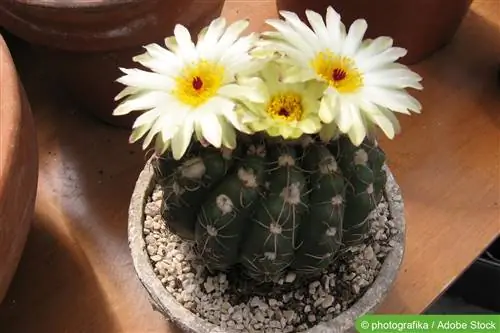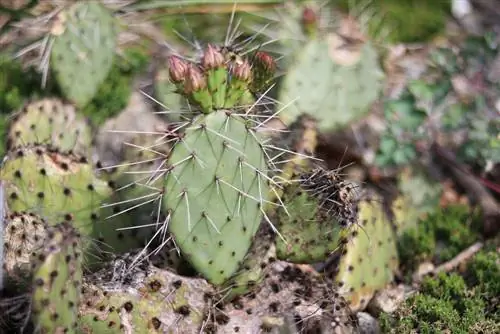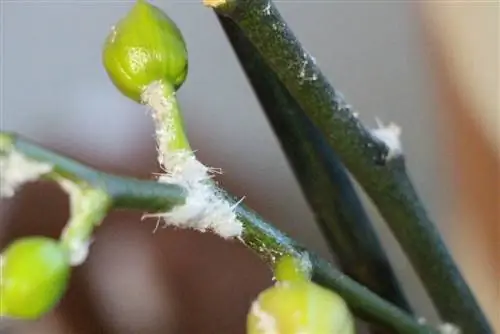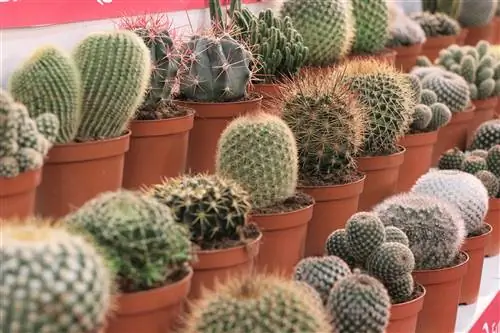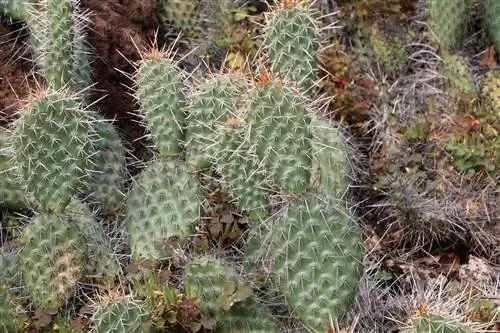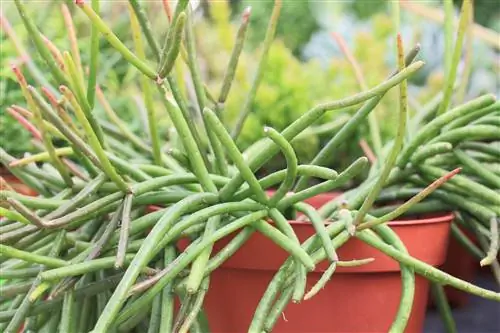- Author admin [email protected].
- Public 2023-12-17 03:39.
- Last modified 2025-06-01 06:48.
Gymnocalycium cacti are characteristically round and stand out with their flowers. In stores they often and seemingly simply display them, but when it comes to self-care, this usually doesn't work too well. Cultivating succulents is not at all complicated and can easily be carried out even by beginners and plant lovers without a green thumb. Anyone interested can find out what to look out for in the plants and which types of Gymnocalycium cacti are particularly beautiful or suitable here.
Species
There are numerous Gymnocalycium species on the market that impress with their striking flowering, size or shape. The following overview shows a selection of cacti that are particularly decorative:
- Gymnocalycium ambatoense
- Gymnocalycium baldianum
- Gymnocalycium bruchii
- Gymnocalycium mihanovichii
- Gymnocalycium quehlianum
- Gymnocalcium saglione
Gymnocalycium ambatoense is quite large with a diameter of up to 15 cm, but the main eye-catchers on the cactus are its spines and flowers. Straight in the middle and slightly curved at the edge, the thorns provide an attractive base for the bell-shaped white flowers, which have narrow, colored stripes. Gymnocalycium baldanium with a diameter of 6 cm seems rather inconspicuous at first glance. Over time, however, individual plants can form impressive groups. Add the light to dark red flowers and the G. baldanium is an eye-catcher. Gymnocalycium bruchii has a maximum diameter of 6 cm and reaches heights of around 3.5 cm. These compact dimensions make this cactus particularly attractive in groups. When the G. bruchii blooms, however, its full beauty is revealed. As a flowering and richly flowering cactus, it is simply a highlight in light tones.
Gymnocalycium mihanovichii are probably the best known of the Gymnocalycium cacti. They do not contain chlorophyll and are therefore usually bright red. So that they can be cultivated as houseplants, they are grafted onto another cactus rootstock. This is also where their exotic appearance comes from. Gymnocalycium quehlianum measures around 15 cm in diameter and is clearly ribbed, making it very decorative - even without flowers. However, the flowers are also eye-catching, bright white that turns to a strong red in the middle. Gymnocalcium saglione is a true giant among this cactus species. It can reach a good 30 cm in diameter and climb to a proud height of up to 90 cm over the years. As the largest cactus of the Gymnocalycium species, G. saglione is not only impressive. Blue-green in color and floriferous, it is also a very attractive plant.
Location
Bright but not too bright, warm but not hot - Gymnocalycium cacti like the happy medium and are therefore quite easy to please. The location should be sunny or in light shade. A window sill facing east or west would be beneficial. When it comes to temperature, the round cactus is also easy to care for; normal room temperatures are ideal. But Gymnocalycium cacti don't have to stay indoors all year round. During the summer the cactus can and should be outdoors. This stay in the fresh air is good for your long-term he alth. Here too, the blazing midday sun should be avoided. A covered location is therefore advisable.
Tip:
If the Gymnocalycium cactus loses its typical round shape, it is too dark.
Substrate
Loose and rich in humus, moderate nutrient content and loose texture - the substrate for the Gymnocalycium cactus must meet these requirements. Cactus or succulent soil is also suitable, as is a mixture of three parts compost soil and one to two parts sand. Purely mineral substrates can also be suitable for the Gymnocalycium cacti, but they must:
- be lime-free
- have a slightly acidic pH value
- have permeable texture
Tip:
If you don't want to make your own mixture, cactus soil is the best choice.
Pouring
When watering the Gymnocalycium cacti, sensitivity is required. Although the cactus needs plenty of water from spring to autumn, it is very sensitive to moisture. Watering is therefore regular and moistening. However, you have to wait between watering until the top layer of soil has dried out. The succulent does not tolerate drying out completely, so frequent checks are recommended. Since the Gymnocalycium cactus does not tolerate lime, only soft water should be used. Collected rainwater would be ideal. If you cannot provide this, you should instead let tap water sit for a week and water slowly. The lime settles at the bottom, so as long as the jug is not completely emptied, the lime remains in the water.
Tip:
Gymnocalycium cacti should be watered from below, i.e. they should be able to soak from a saucer.
Fertilize
During growth - i.e. from March to August - the Gymnocalycium cactus is grateful for an additional supply of nutrients. This should be administered in the form of a complete fertilizer rich in potassium every two weeks. The fertilizer is ideally dissolved directly in the irrigation water or a liquid preparation is used, as the agent cannot be added to the soil from above. Fertilization of the Gymnocalycium cacti must be stopped by the end of August at the latest. This is necessary so that the plant can prepare for winter rest.
Propagate
The Gymnocalycium cactus reproduces via runners or so-called children that form next to the mother plant. Even if you don't want to propagate the cactus, you should remove them as soon as the pot diameter becomes too narrow for the plant. Alternatively, you can of course also switch to a larger planter. The large mother plant with the smaller daughter plants is visually quite appealing. However, for the individual propagation of the Gymnocalycium cacti, the procedure is as follows:
- The runners, which are at least 2 to 3 cm in size, are cut off close to the mother plant with a clean, sharp knife.
- The fresh cut surfaces of the separated shoots are susceptible to rot and must therefore not be placed directly in the soil. First they have to dry, which takes one to three days depending on the temperature and humidity.
- Once the cut surfaces of the Gymnocalycium Kindel have dried, they are inserted into the substrate about a centimeter deep. The mixture described above or cactus soil can be used as soil.
- The planter is placed in a sunny and warm place. The temperature should be at least 20 °C.
- During the first three to four weeks, the soil should be kept slightly moist throughout. The daughter plants are then cultivated in the same way as the mother plant itself.
In addition to propagating via runners, it is also possible to obtain seeds from the Gymnocalycium cactus and cause them to germinate. Separated from the seed bodies after flowering, sowing should take place immediately afterwards. The faster the seeds are spread on substrate and moistened, the higher the chances of success. Stored seeds, on the other hand, rarely germinate, which makes this form of propagation so unsafe. To germinate, Gymnocalycium cacti need a temperature of around 20 °C and a bright location with direct sun. Cactus soil or a soil mixture that only lightly covers the seeds or only serves as a substrate can be used as a substrate. The soil must be kept moist.
Wintering
The Gymnocalycium cactus is overwintered at 5 to 8 °C and remains bright. Fertilization is stopped completely and watered so that the soil does not dry out completely but is never wet. Sips of water are ideal. To prevent any germs that may be present from spreading and infecting the cacti, the plants should not be placed too close together. It also needs to be ventilated every now and then.
Repotting
An annual repotting of the Gymnocalycium cacti is usually not necessary, but to be on the safe side the root ball should be checked in spring. To do this, it is briefly lifted out of the pot immediately after winter rest, when the soil is still quite dry. If roots are visible on the outside of the soil, a larger planter should be chosen. Every two years the root ball is removed from the soil and placed in fresh substrate. A pot change is only necessary if the roots fill the container. Due to the shape and spines of the cacti, repotting some types of Gymnocalycium cacti is not that easy. When moving the plant, it is therefore advisable to use pieces of Styrofoam as protection and for access. Alternatively, tongs with wide surfaces, such as pastry tongs, can be used.
Conclusion of the editors
Origin & characteristics
- The Gymnocalycium cacti are interesting plants that can be easily cultivated even by beginners in plant care.
- If you meet the requirements, you can look forward to more than decorative flowers and long-lasting houseplants.
- Gymnocalysium means naked calyx. The plant belongs to the cactus family and is a succulent.
- The name Naked Calyx comes from the fact that these plants are bare.
- In contrast to other cacti, which are hairy, bristly and covered with spines, this genus is naked.
- These cacti are native to all of South America.
- Most plants stay rather small. They grow in a depressed, spherical to flat shape. As they get older, they can also grow thickly columnar.
- Cacti usually have 4 to 15 ribs. Their size can vary greatly. They grow as single shoots or with abundant sprouts.
“Red Ball Cactus”
- The flowers open during the day and are white and pink, in a few species also yellow or red. The calyx is bare and scaly.
- The best known species in this genus are the chlorophyll-free mutations.
- They are sold in stores under the name Red Ball Cactus.
- Instead of green, they have a bright red color. They can also occur in colors ranging from yellow to purple.
- Since they are unable to photosynthesize themselves, they must be grafted onto a green cactus.
- This serves as a base and nutrient supplier.
Location & Substrate
- In summer the Gymnocalyciums can be placed outdoors.
- Rain usually does not harm the plants, only continuous rain should be avoided.
- However, a very permeable substrate should be used.
- It is also important that the substrate should always have a weakly acidic soil reaction.
- As soon as this changes to an alkaline reaction, the growth of the gymnocalycia stops.
- A generous addition of minerals promotes growth. You can also use a purely mineral substrate.
- The substrate should be loose and permeable to air and must not contain any lime.
- This usually leads to good, strong thorns, plenty of roots and too many flowers.
- A used substrate should be removed immediately.
- It's best to repot the cacti every year. This prevents growth from stopping.
Irrigation
- The cacti like a bright to partially shaded location. They usually cannot tolerate blazing sun.
- It is best to initiate the growth of the Gymnocalycium in spring when the weather is nice by spraying the plants.
- The buds usually only appear a little later. During the growth phase, the plants should be supplied with plenty of water.
- On warm days you can spray them with rainwater in the evening.
- Under no circumstances should you spray it while the plant is in the sun, as this will cause burns.
Overwintering & Propagation
- The plants overwinter at temperatures of around 5 to 8 °C.
- They should be completely dry. Bright wintering is not necessary.
- Propagation is relatively easy from seeds. The germination result depends on the age of the seed.
- The best results are achieved with completely fresh seeds or with seeds stored for about a year.
- The germination power of imported seeds is often low.
- The temperatures should not exceed 20 °C.

